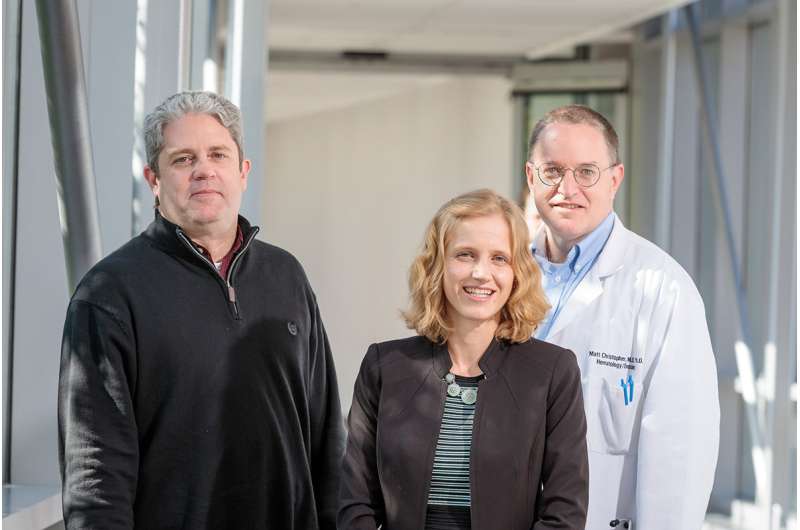Relapsed leukemia flies under immune system's radar

Patients with acute myeloid leukemia (AML), an aggressive cancer of the blood, often are treated with stem cell transplantation, in which a compatible donor's blood-forming cells are transplanted into a patient. The donor's immune cells then attack and kill the leukemia cells. But even if this treatment initially is successful, many patients experience a recurrence of the leukemia after transplantation that often proves fatal.
A study from Washington University School of Medicine in St. Louis offers a potential explanation for why many AML patients experience a relapse after a stem cell transplant, and suggests a therapeutic approach that may help to place relapsed patients back into remission. The research is published online Oct. 31 in the New England Journal of Medicine.
The study involved the DNA sequencing of AML cells from 15 patients who relapsed after stem cell transplants and, as a comparison, 20 AML patients who relapsed after chemotherapy. The researchers found that the mutations that were present in relapsed AML cells after transplantation were similar to those after chemotherapy.
But the researchers found a significant difference in the cells' patterns of gene expression, that is which genes are active and to what degree. The cells from patients who relapsed after transplant often had greatly reduced expression of genes that were involved with the recognition of cancer cells by the immune system. In other words, when the cancer came back in these patients, it returned in a kind of stealth mode. These stealth leukemia cells lacked proteins that the donor's T cells use to identify them. When the donor's immune cells can no longer detect the leukemia cells, the T cells fail to destroy them.
The investigators also identified a natural signaling molecule—interferon gamma—that forced the stealth leukemia cells to reveal themselves again, presenting new therapeutic possibilities for AML patients who relapse in this way.
"We were surprised by these findings because we and others had previously studied samples of relapsed leukemia in every which way," said senior author John F. DiPersio, MD, Ph.D., the Virginia E. and Sam J. Golman Professor of Medicine in Oncology and director of the Division of Oncology at the School of Medicine. "But there's a rational explanation, since the way stem cell transplants attack leukemia—through an immunologic mechanism—is going to favor the survival of cancer cells that become invisible to the immune system."
The team that performed the study was co-led by Timothy J. Ley, MD, the Lewis T. & Rosalind B. Apple Professor of Medicine; and co-first authors Matthew J. Christopher, MD, Ph.D., an assistant professor of medicine; Allegra A. Petti, Ph.D., an assistant professor of medicine; and Michael P. Rettig, Ph.D., an associate professor of medicine, and a number of other colleagues from the McDonnell Genome Institute and the Division of Oncology. The authors are all affiliated with Siteman Cancer Center at Barnes-Jewish Hospital and Washington University School of Medicine.
The researchers found that the relapsed cancer cells did not have recurring genetic mutations that caused them to go into stealth mode by disabling the genes that control immune recognition. Rather, the cells possessed something like a "dimmer switch," dialing down the expression of immune markers. And dimmer switches, unlike mistakes in DNA, are often easier to adjust.
An immune signaling molecule called interferon gamma has long been known to dial up the body's natural immune defenses. Indeed, interferon gamma is vital to the body's response to infection, and is widely known for its ability to increase expression of the immune markers that these stealth cancer cells have hidden away.
"When we treated leukemia cells from patients' relapse with interferon gamma, it turned back on those immune markers that had become invisible, suggesting that this process is reversible," said Christopher, who also treats patients at Siteman Cancer Center.
Interferon gamma is approved by the Food and Drug Administration for treatment of a rare condition called chronic granulomatous disease, an inherited immune disorder that results in frequent and life-threatening bacterial or fungal infections.
DiPersio said the research team is seeking to identify other small molecules that may have the same effect as interferon gamma. In the 50 percent of patients who relapsed after transplant but whose cells did not go into stealth mode, the reason for relapse is not yet clear. Further studies involving many more patients will be needed to determine whether other DNA mutations, or alternative dimmer switch mechanisms, may be involved in relapsed AML.
More information: Christopher MJ, Petti AA, Rettig MP, et al. Immune escape of relapsed AML cells after allogeneic transplantation, New England Journal of Medicine. Oct. 31, 2018.




















